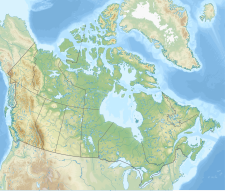Gremlin slobodorum
| Gremlin Temporal range: Campanian,
| |
|---|---|

| |
| Restoration | |
| Scientific classification | |
| Domain: | Eukaryota |
| Kingdom: | Animalia |
| Phylum: | Chordata |
| Clade: | Dinosauria |
| Clade: | †Ornithischia |
| Clade: | †Neornithischia |
| Clade: | †Ceratopsia |
| Clade: | †Euceratopsia |
| Family: | †Leptoceratopsidae |
| Genus: | †Gremlin Ryan et al., 2023 |
| Species: | †G. slobodorum
|
| Binomial name | |
| †Gremlin slobodorum Ryan et al., 2023
| |
Gremlin (named after the mythical creature of the same name) is a genus of leptoceratopsid ceratopsian dinosaurs from the Campanian stage of the Cretaceous period, 77 million years ago. It contains one species, Gremlin slobodorum, named in 2023 by Michael J. Ryan and colleagues from a frontal bone found in the Oldman Formation of Alberta. It can be distinguished from other leptoceratopsids by a ridge on the frontal that runs transversely from the midline of the skull outwards to the top end of the orbit.[1]
Discovery and naming
[edit]The Gremlin holotype specimen, TMP 2011.053.0027, was discovered in sediments of the Oldman Formation in southern Alberta, Canada. The specimen consists of an isolated right frontal bone which has lost portions of its anterolateral margin, possibly due to erosion.[1] In a 2022 conference abstract authored by L. Micucci and colleagues, they tentatively referred the specimen to Cerasinops since its holotype was found in rock layers of a similar age.[2]
In 2023, Ryan and colleagues described Gremlin slobodorum as a new genus and species of leptoceratopsid based on these fossil remains. The generic name, "Gremlin", refers to the small troublesome mythical creatures of the same name. The specific name, "slobodorum", honors Ed and Wendy Sloboda who have contributed to paleontology in Canada and were involved in the holotype's discovery.[1]
Classification
[edit]Ryan et al. (2023) recovered Gremlin as a non-coronosaurian ceratopsian using the dataset of Arbour and Evans (2019).[3] Their phylogenetic analyses recovered an unresolved polytomy of most leptoceratopsids and some other similar dinosaurs at the base of the Coronosauria, with the leptoceratopsids Gryphoceratops and Unescoceratops recovered as sister taxa. The results of their phylogenetic analyses are displayed in the cladogram below.[1]
| Ceratopsia |
| |||||||||||||||||||||||||||||||||
References
[edit]- ^ a b c d Ryan, M.J.; Micucci, L.; Rizo, H.; Sullivan, C.; Lee, Y.-N.; Evans, D.C. (2023). "A New Late Cretaceous leptoceratopsid (Dinosauria: Ceratopsia) from the Oldman Formation (Campanian) of Alberta, Canada". In Lee, Y.-N. (ed.). Windows into Sauropsid and Synapsid Evolution: Essays in Honor of Prof. Louis L. Jacobs. Seoul: Dinosaur Science Center Press. pp. 151–165. ISBN 978-89-5708-358-1.
- ^ Micucci, L.M.; Evans, D.C.; Rizo, H.; Ryan, M.J. (2022). A new Late Cretaceous leptoceratopsid specimen from the Oldman Formation (Campanian) of Alberta, Canada. Canadian Society of Vertebrate Palaeontology Annual Meeting. Virtual. p. 35.
- ^ 1Arbour, Victoria M.; Evans, David C. (2019-11-07). "A new leptoceratopsid dinosaur from Maastrichtian-aged deposits of the Sustut Basin, northern British Columbia, Canada". PeerJ. 7: e7926. doi:10.7717/peerj.7926. ISSN 2167-8359. PMC 6842559. PMID 31720103.
{{cite journal}}: CS1 maint: numeric names: authors list (link)





